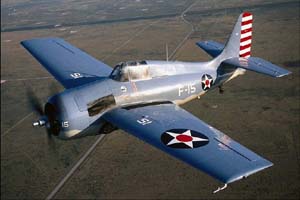General Motors FM-2 Wildcat
U.S. Navy Fighter
 |
FM-2 in the paint scheme and markings of the F4F-3 of Lt.
"Butch" O'Hare, USN, Feb. 1942. Image source: The Confederate Air Force Ghost Squadron CD-ROM produced by Corel. Photos by Bill Crump. |
The Grumman Aircraft Engineering Co. had provided the U.S. Navy with carrier-based biplane fighters since 1931, and in 1936, offered a design for a monoplane, the XF4F-2. The Navy liked a competing design, the Brewster F2A Buffalo, but also ordered 54 of the F4F-3 Wildcats from Grumman, in August 1939.
It was fortunate that the Navy purchased the Wildcat as a backup to the success of the Buffalo, as the Brewster design proved to be weak and ineffective as a carrier fighter. By the end of 1941, 345 Wildcats had been delivered to the U.S. Navy, and the British Royal Navy also operated the design, calling them Martlet Is.
When America entered the Second World War on 7 December, 1941, most of the carrier fighter squadrons were equipped with F4F-3s, and the Wildcat bore the brunt of the carrier-based fighting in the Pacific until the introduction of its successor, the Grumman F6F Hellcat in late 1943.
In early 1942, a new version, the F4F-4 was introduced with folding wings, which allowed more of the Wildcats to be carried on each carrier. With the fixed wing versions, a fighter squadron numbered only 18 planes, however the folding wings allowed 27 planes to be carried per squadron. Pilots quickly stopped complaining about the additional weight of the folding wings when they realized it meant a lot more friendly fighters in the air at one time.
On 20 February, 1942, Lt. Edward "Butch" O’Hare, flying an F4F-3 Wildcat, shot down five Japanese Betty bombers attacking his ship, the USS Lexington, thus becoming the first U.S. Navy ace of World War II. O’Hare was awarded the Medal of Honor for this action, and Chicago’s O’Hare Airport is named in his honor.
As the heavier and faster F6F Hellcat began to replace the Wildcat on the larger fleet carriers in late 1943, the Wildcat continued to fight from the shorter decks of the escort or "jeep" carriers. Production of the F4F-4 was shifted to General Motors Eastern Division, in New Jersey, where they produced the FM-1 and FM-2 versions of the Wildcat.
The FM-2 was the last and most powerful Wildcat, often being called the "Wilder" Wildcat, as it had a more powerful Wright R-1820 engine of 1,350 hp and weighed about 350 pounds less than the F4F-4.
The CAF has two FM-2 Wildcats in its fleet and this Wildcat is painted as the F4F-3 flown by Lt. "Butch" O'Hare. It is currently based in the Hampton Roads, Virginia area. The other Wildcat is based in San Diego, California, with the Air Group One Wing of the CAF.
Note: The CAF FM-2 Wildcat which was painted as "Butch" O'Hare's aircraft was severely damaged in an accident while landing in October 2003. Look here for the official press release. The CAF's other FM-2 has been repainted as a British Martlet.
Specifications
One Pilot One Wright R-1820-56 Engine Four .50 caliber Machine Guns Six 5-inch HVAR Air to Ground Rockets Max. Speed 332 mph @ 28,800 feet Initial Climb Rate 3,650 ft/min |
Length 28' 11" Max. Weight 8,271 lbs Normal Fuel 117 gallons Normal Range 900 miles |